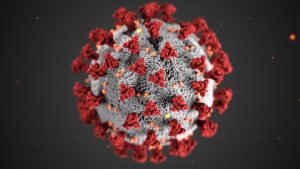A Pill to Treat COVID-19 and the Shape of Things to Come
By Robert J. Kriss, C2ST Editor
Pfizer recently used the Advanced Photon Source (“APS”), a powerful x-ray machine operated by the U.S. Department of Energy’s Argonne National Laboratory, to help them develop a pill that appears to reduce the risk of hospitalization and death among COVID-19 patients by 89%. Pfizer is now seeking FDA approval to administer the drug to patients. The process Pfizer used to develop this pill may be the blueprint for preventing future pandemics.

To understand the process, a brief summary of the biochemistry is useful. Humans and viruses are comprised of proteins, which are molecules composed of thousands of atoms arranged in various complex and irregular 3-D configurations, sometimes resembling a wad of chewed gum. The shape of the protein (configuration of atoms) is critical to its functions since the geometry affects how the protein molecule will chemically react with other proteins in the body.
These protein molecules cannot be “seen” by the human eye. But the APS x-ray machine can look at tiny crystals grown from the virus’s proteins and create enlarged, readable images of the molecules, which reveal their atomic structures.
Pfizer used the APS x-ray machine to learn the structure of the SARS-CoV-2 protein involved in replicating the virus. Then it examined the shapes of thousands of potential drug candidates to find a molecule that would bind to a critical part of the SARS-CoV-2 virus, thereby changing its shape. After the virus protein’s shape was altered by the drug molecule, the protein no longer could perform its role in the replication process. As a result, the SARS-CoV-2 virus was unable to replicate and the COVID-19 infection was stopped before it became so serious as to require hospitalization. Think of it like a lock and key. If you were able to solder a pellet to part of the key, it could no longer open the lock.
In the future, as the shapes of our viral attackers change, we hope to be able to more and more quickly “see” them and figure out how to neutralize them with the appropriately shaped drug molecule. Artificial intelligence-enabled supercomputers, such as the forthcoming Aurora at Argonne, will assist in sifting through potential drug candidates and narrowing the number of potential candidates for physical testing. The computer will “learn” how various atoms in different configurations bind to each other and use this knowledge to predict how drug molecules will interact with the virus. Ultimately, the drug candidates identified by AI will have to be physically tested to determine which drugs work. As the AI improves, the time to develop drugs will shorten.
Twenty years of research enabled us to respond to COVID-19 in about a year. Our experience with the COVID-19 and enhancements to AI will help in our ability to respond to the next pandemic. Tools such as the APS and the AI supercomputer could be key in preventing future pandemics. For more information on the development of the drug and the shape of things to come, check out the following links:
- https://www.anl.gov/article/advanced-photon-source-helps-pfizer-create-covid19-antiviral-treatment
- https://www.anl.gov/article/using-the-advanced-photon-source-researchers-advance-battle-against-covid19
- https://www.anl.gov/article/argonne-accelerates-covid-antiviral-discovery-with-ai
Remember that national labs, such as Argonne National Laboratory, are federally funded. Our tax dollars are working to save lives. Companies, such as Pfizer, use these labs to develop their products. The partnerships between the national laboratories and private enterprise are critically important to protecting our health and extending our lives.